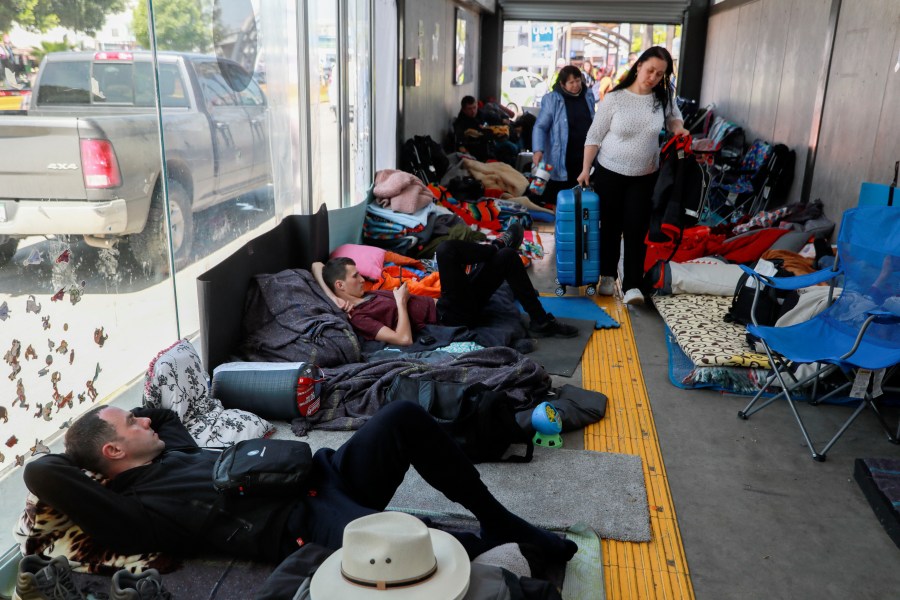Ukrainian refugees seeking asylum in US waiting at Mexico border
TIJUANA, Mexico (NewsNation) — The call to cross into the U.S. happens multiple times a day at a makeshift camp near California’s San Ysidro Port of Entry along the U.S.-Mexico border.
It’s part of a new semi-official system set up by various churches and humanitarian groups to help Ukrainian refugees get to the United States faster.
In just the past week, the number of Ukrainian refugees waiting in Tijuana to enter the U.S. has grown from hundreds to thousands.
Many sleep in tents on the ground. Others find space in a nearby bus shelter — suitcases with their life’s possessions just feet away.
Everyone awaits the same call — the sound of their number being read aloud — signaling their opportunity to talk to a U.S. Border agent. After that, they hope to be granted humanitarian parole and allowed into the United States.
Most have endured dangerous, multi-leg journeys on their way to Mexico, often fleeing towns that have been decimated by Russian forces.
When they finally arrive in Tijuana, those seeking asylum are added to a computerized list to secure a spot in line. Last week, the list saw less than 1,000 new arrivals from Ukraine. This week, the number has already swelled to 2,500.
“None of this was here (last week). (When) I came on Tuesday, (there were) maybe 50 tents and people. There was nothing. It’s really exponential, like ten times from what it was,” said Anna, a Ukrainian-American volunteer nurse who traveled from Spokane, Washington to help out at the border.
Despite the surge in refugees, however, only about 150 people are being processed each day due to limited Customs and Border Patrol (CBP) staffing. That’s expected to improve in the coming days.
“The CBP department, they are really doing their job. They are increasing the attention to Ukrainian people so I think it’s going to be faster,” said Adriana Espinoza Nolasco, undersecretary of immigration affairs in Baja California.

why Mexico?
Many fleeing the war in Ukraine see Mexico as their best chance to get to the United States. That’s because it’s much easier to acquire a tourist visa to fly there than it is to travel to America. Once in Mexico, refugees head north to the U.S. border, toward the San Ysidro port of entry near Tijuana, to seek asylum.
There’s just one problem: The U.S. border technically remains closed to asylum seekers due to the Title 42 health rule put in place to prevent the spread of coronavirus.
On Friday, President Joe Biden’s administration announced an end to the rule but that change won’t take effect until May 23. In the meantime, Ukrainian refugees continue to pour into Tijuana.
As the number of refugees stuck in limbo grows, the U.S. has allowed some Ukrainians to enter the country by means of humanitarian parole — a temporary protection mechanism that allows immigrants who are otherwise ineligible to stay in the country for a maximum of one year.
But even emergency measures such as humanitarian parole can take time to process, especially when the number of applicants swells to the thousands. Late last month, Biden said the U.S. would welcome up to 100,000 Ukrainian refugees but it’s still unclear what an expedient, formal resettlement process looks like if numbers reach those levels.
Since the war began. more than 4 million people have fled the war-torn country; most have gone to nearby Poland.

Ukrainian-Americans step up to help
With thousands seeking aid at the border, Ukrainian communities in the United States are mobilizing to help.
“Knowing that it could have been us, it doesn’t make us any better or different because we came here at an earlier time … I think it hits different when it’s home,” said Tanya, a Ukrainian-American volunteer nurse from Sacramento.
California’s capital is home to the highest concentration of Ukrainian immigrants in the country, with about 18,000 people.
NewsNation spoke with multiple Ukrainian-American volunteers at the border, some traveling from as far away as New Hampshire, to lend a helping hand to their fellow countrymen. In some cases, those volunteers have helped streamline a chaotic and confusing asylum process.
After noticing a significant influx of people, a group of volunteers came up with the number system to give everyone a fair chance.
“We just got all together, started working on a process and created a system just to help ourselves and help the Mexican and American system to help them cross the people,” said Alex Illuyk, a Ukrainian volunteer from New Hampshire.
Those on the ground know more help will be needed to manage the increasing flow of refugees. Nearby, the Benito Juarez Sports Complex has already been converted into an emergency shelter for more than 1,500 asylum seekers.
Humanitarian groups plan to open more shelters in the coming days.
“As long as the U.S. government will wait to make some decisions, we will find a way to feed people and make them safe … this is not the American Dream, this is running from war,” said Anastasiya Polovin, a Ukrainian-American volunteer.














